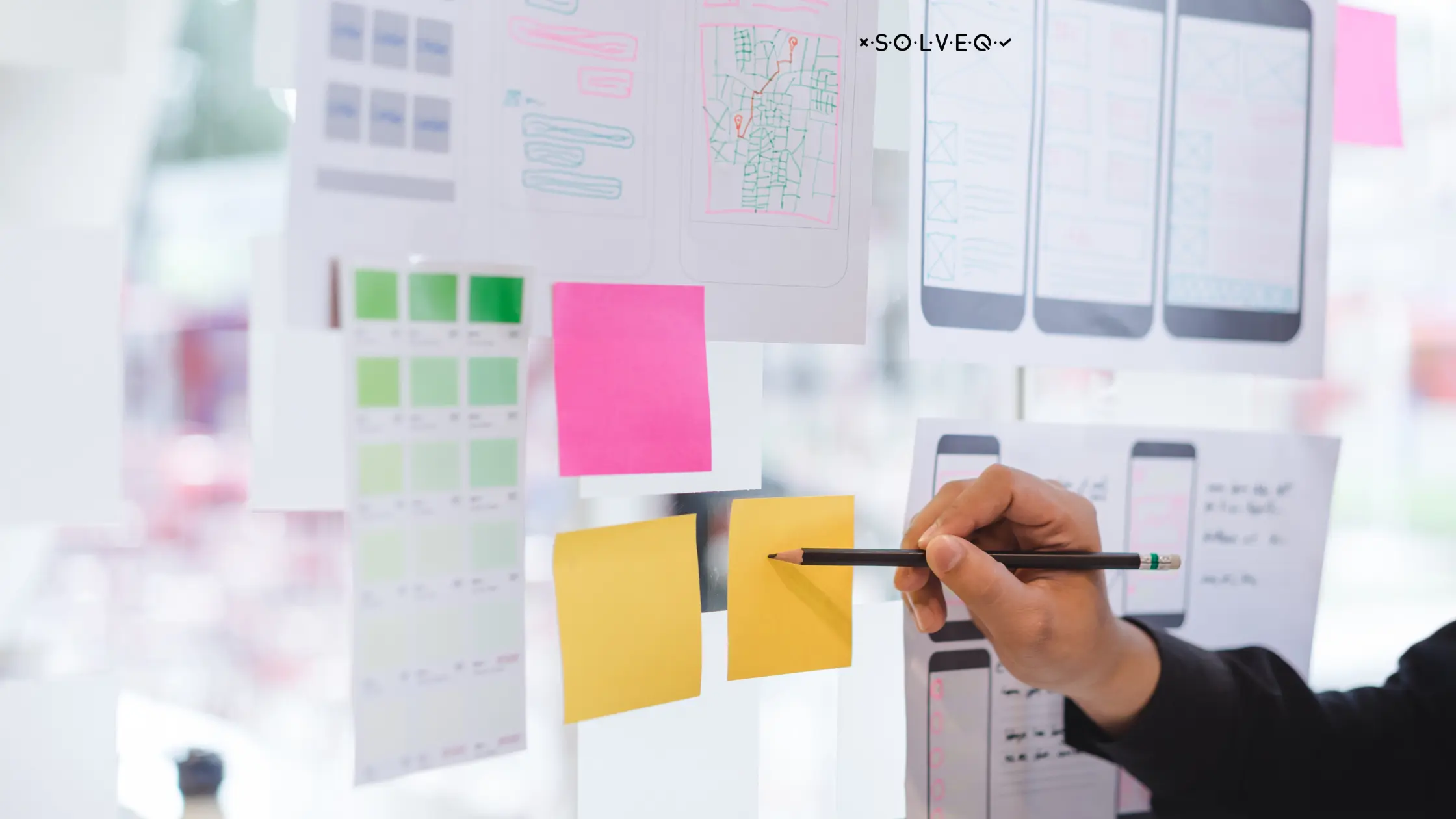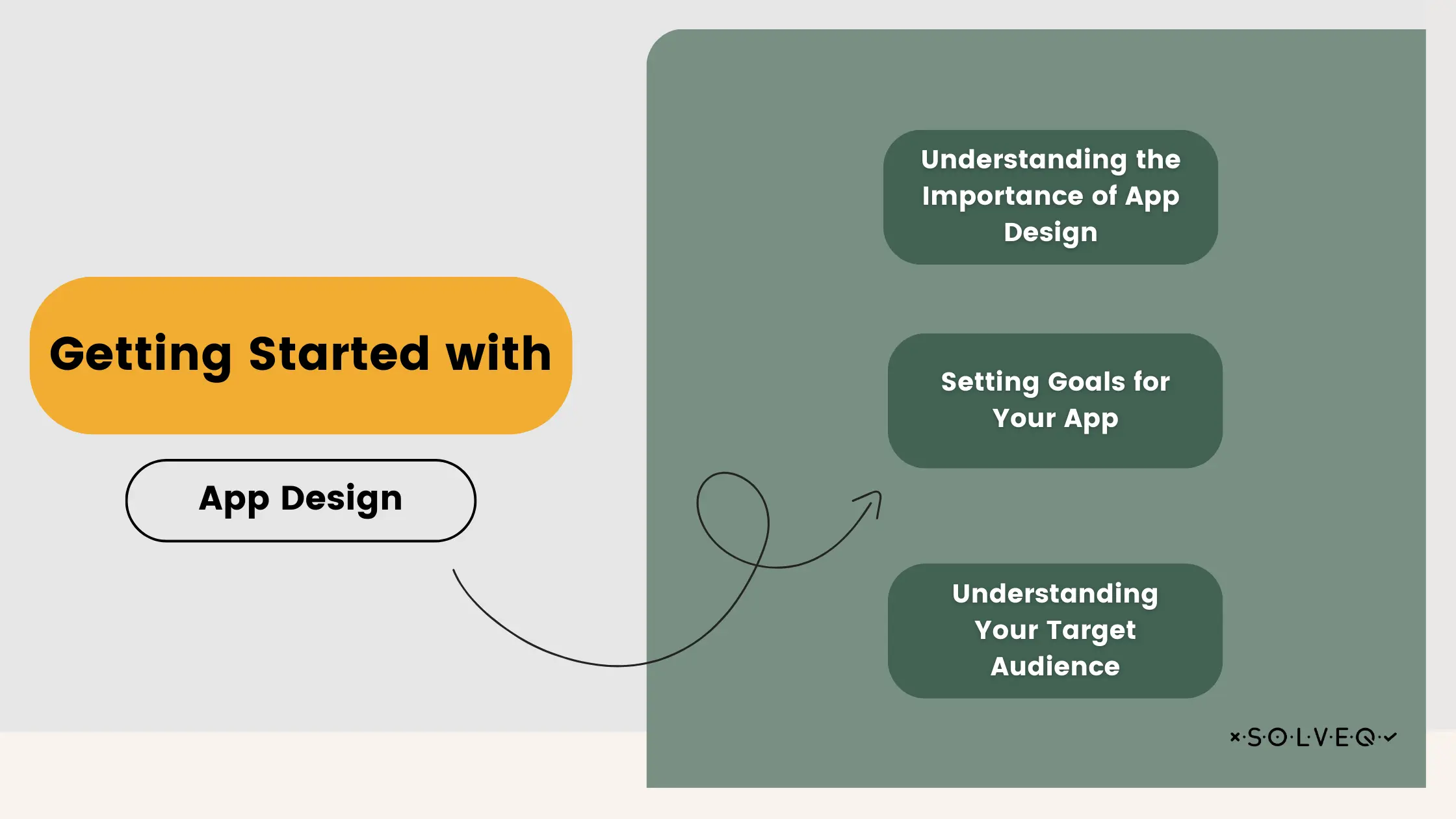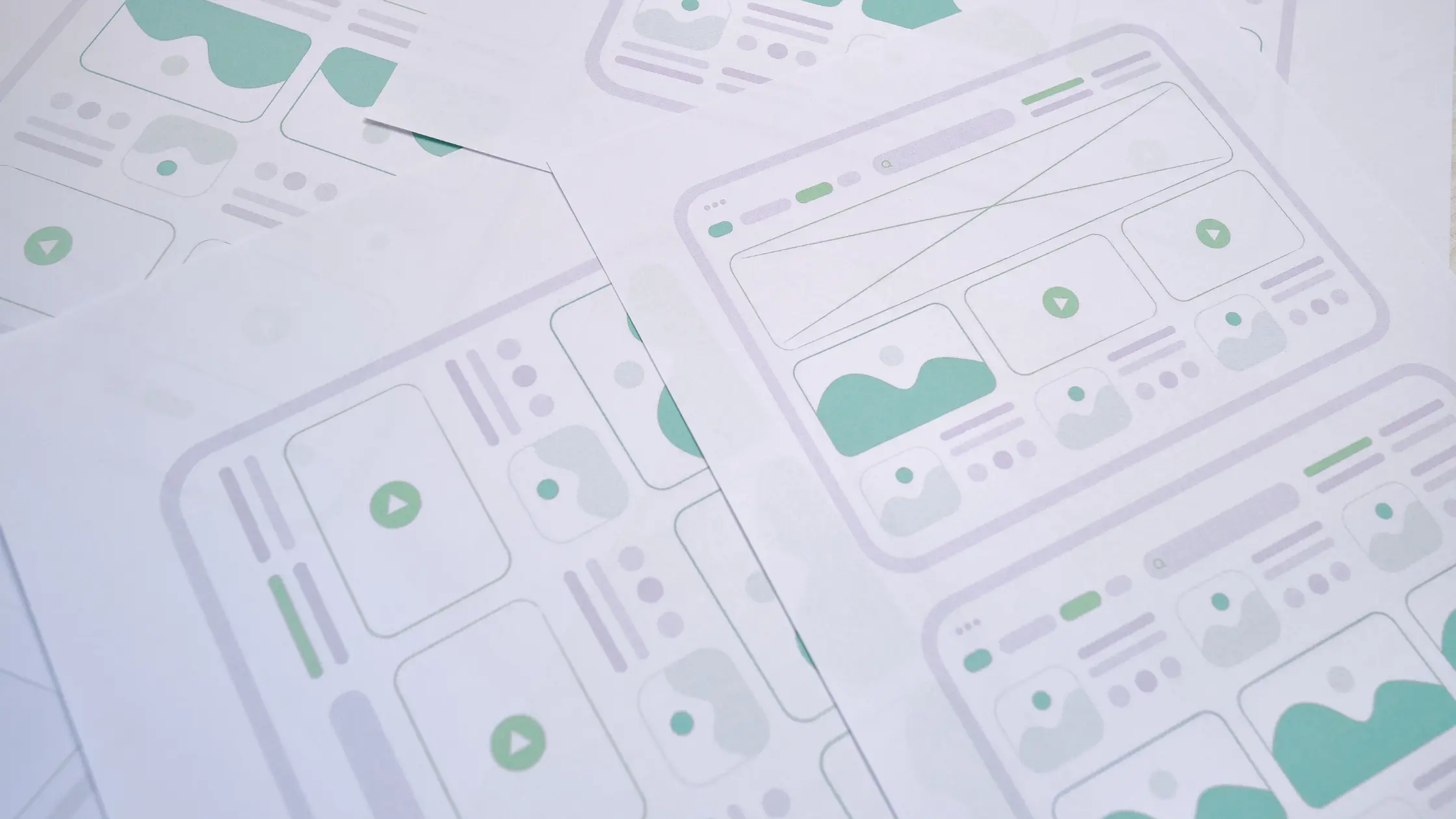How to design an app in 2024: an ultimate guide
26 Mar 2024 • 22 min read

Marcin Kulawik

In the digital age of 2024, the realm of mobile applications has become an integral part of our daily lives, revolutionizing the way we interact with technology. The art of mobile app design stands at the forefront of this revolution, blending creativity with functionality to enhance user experiences. With the app market more competitive than ever, exceptional design is not just a luxury, but a necessity for success. This comprehensive guide delves into the crucial aspects of app design, from initial concepts to emerging trends, offering insights to both novices and seasoned designers alike. Embark on this journey to uncover the strategies that will elevate your app to new heights in a world where design makes all the difference.
Getting Started with App Design
As we delve into the world of app design in 2024, understanding the significance of design and aligning it with your app's goals and audience is crucial. This initial stage sets the tone for your app's journey from concept to reality.

Understanding the Importance of App Design
In 2024, app design is more than just an artistic endeavor; it's a crucial factor in determining an app's success. Good design goes beyond the surface, deeply influencing how users interact with and perceive an app. Let's consider why design is so important:
- User Experience (UX): A well-designed app provides a seamless, intuitive user experience, making it easier and more enjoyable for users to navigate.
- Brand Identity: Your app's design is a reflection of your brand, helping to establish and reinforce your brand identity in the digital space.
- Competitive Edge: In a market flooded with apps, a superior design can set your app apart from competitors, attracting and retaining users.
Setting Goals for Your App
Before diving into the design process, it's crucial to set clear, specific goals. This ensures your design efforts are focused and effective. Consider the following steps:
- Identify the Core Functionality: What is the primary purpose of your app? Is it to educate, entertain, facilitate tasks, or something else?
- Define Success Metrics: What does success look like for your app? This could be user engagement levels, download numbers, or revenue targets.
Understanding Your Target Audience
Knowing your audience is key to creating a design that resonates with them. Here are some points to consider:
- Demographics: Age, gender, location, and other demographic factors can greatly influence design preferences.
- User Preferences and Behaviors: What do users in your target market value in an app? Are they looking for speed, simplicity, innovation, or social connectivity?
- Technical Proficiency: The technological savviness of your audience affects how complex or straightforward your design should be.
By keeping these elements in mind, you’re laying a strong foundation for your app's design process. As we progress into the specifics of app design in subsequent sections, remember that your initial goals and understanding of your audience are what will guide your decisions and help your app stand out in a crowded marketplace.

Design Research and Planning
As we transition from understanding the foundational aspects of app design, we now venture into the critical phases of research and planning. This process is essential for aligning your app's design with market trends and user expectations, forming the backbone of a successful app strategy.
Conducting Market and User Research
The foundation of a successful app design lies in thorough research. Understanding the market and your users is pivotal. Here's how you can approach this:
- Market Analysis: Investigate current trends, competitors, and market needs. What are the most successful apps doing right? What gaps are there in the market that your app could fill?
- User Surveys and Feedback: Collect data directly from potential users through surveys, interviews, and feedback. This firsthand information is invaluable for tailoring your app to meet real user needs.
Developing User Personas and Scenarios
Once you've gathered sufficient data, the next step is to create user personas and scenarios:
- User Personas: These are fictional characters based on your research that represent the different user types who might use your app. Include details like age, occupation, interests, and tech-savviness.
- Scenarios: Develop scenarios or stories that show how these personas would interact with your app. This helps in visualizing the user journey and identifying key features and functionalities that will enhance the user experience.
Creating a Design Strategy
With your research and personas in hand, you can now formulate a design strategy. This should encompass:
- Feature Prioritization: Based on your research, prioritize the features that are most important to your target audience. Remember to balance user needs with technical feasibility and business objectives.
- Design Principles: Establish a set of design principles that align with your app's goals and brand identity. This might include simplicity, user-centric design, innovation, or consistency.
- Roadmap for Design and Development: Outline a phased approach for your app's design and development. This includes wireframing, prototyping, user testing, and iteration stages. Setting clear milestones will keep the project on track and ensure that every design element serves the app's core objectives.
By methodically working through these stages of design research and planning, you set a solid groundwork for your app. This process not only aligns the design with user expectations and market needs but also streamlines the development process, paving the way for a successful app launch.

Creating a Design Strategy
With a deep understanding of your market and user personas, it's time to forge a path forward with a clear design strategy. This strategy will serve as a blueprint, guiding every design decision you make and ensuring consistency throughout the app.
Outlining Design Principles and Guidelines
- Defining Core Principles: Establish a set of core design principles that reflect your app’s purpose and brand identity. These might include simplicity, user-centricity, or innovation.
- Developing Guidelines: Create comprehensive design guidelines that detail how your design principles will be applied. This can include aspects like layout structures, color schemes, typography, and more.
Choosing a Design Style and Theme
- Selecting a Style: Decide on a design style that resonates with your target audience and reinforces your app’s purpose. This could range from minimalistic and clean to vibrant and dynamic.
- Theme Consistency: Ensure that the chosen theme is consistently applied across all elements of the app to create a cohesive user experience. This includes interface elements, graphics, icons, and even sound design.
This design strategy, built on the foundations of research and planning, sets the stage for the next steps of your app's journey. It provides a clear roadmap for creating an engaging and functional app that truly connects with its users.
UI/UX Design Fundamentals
In the realm of app design, the terms UI (User Interface) and UX (User Experience) are not just buzzwords but the essence of a successful app. Grasping these fundamentals is key to creating an app that's not only visually appealing but also provides a seamless and enjoyable experience for users.
Understanding the Principles of UI/UX
- User Interface (UI) Principles: UI focuses on the app's visual and interactive elements. It's about how your app looks and feels. Key UI principles include clarity, consistency, responsiveness, and aesthetic integrity.
- User Experience (UX) Principles: UX is about how the app operates and how users interact with it. It encompasses usability, accessibility, efficiency, and sometimes even delight. A good UX design makes the app intuitive and easy to use.

Importance of Intuitive Navigation and Layout
- Easy Navigation: Users should be able to find what they need quickly and effortlessly. A well-designed navigation system enhances user satisfaction and engagement.
- Effective Layout: The layout should organize content and features in a way that is logical and aids the user journey. It’s not just about where things are placed, but how they work together to create a cohesive experience.
In 2024, where users have countless apps at their fingertips, an app that masters UI/UX fundamentals stands out. It’s not just about getting users to download your app, but about creating an experience that keeps them coming back. By focusing on intuitive navigation, effective layout, and a harmonious balance between UI and UX, you lay the groundwork for an app that not only looks great but feels right to the user.
Visual Elements in App Design
The visual elements of your app play a critical role in defining its personality and usability. From color schemes to typography, graphics, and icons, each element contributes to the overall user experience and perception of your app.
Selecting Color Schemes and Typography
- Color Schemes: Choosing the right color palette is essential for conveying your app’s mood and brand identity. Colors can evoke emotions, draw attention, and improve readability. Consider accessibility as well, ensuring sufficient contrast for readability.
- Typography: The choice of typeface affects both the aesthetics and readability of your app. It’s important to choose fonts that are easy to read on small screens and that complement your app's style.
Incorporating Graphics and Icons
- Graphics: High-quality, relevant graphics can greatly enhance user engagement. They should align with the app’s theme and be used consistently throughout the app.
- Icons: Icons are a key component of app navigation and functionality. They should be intuitive, recognizable, and consistent with the overall design theme.
The visual design of your app is more than just ornamentation; it's a powerful tool that communicates your brand’s story and assists in the functionality of the app. A well-thought-out visual design not only captivates users but also enhances their experience, making your app both memorable and enjoyable to use.
Prototyping and Wireframing
Prototyping and wireframing are essential steps in the app design process, allowing designers to visualize and test their concepts before development begins.
Tools for Creating Prototypes and Wireframes
- Wireframing Tools: Wireframes are the blueprints of your app. They provide a basic structure for your app’s layout without the distraction of visual design elements. Tools like Sketch, Adobe XD, and Balsamiq are popular choices for creating wireframes.
- Prototyping Tools: Prototypes are interactive demos of your app. They give you a feel for the user experience and functionality. Tools like InVision, Figma, and Axure RP offer powerful capabilities for creating high-fidelity prototypes that mimic the final product.
Testing and Refining Design Concepts
- User Testing: Gather feedback by testing your prototypes with real users. This can reveal insights into user behavior and preferences that you might not have anticipated.
- Iterative Refinement: Use the feedback to refine your design. This iterative process is key to developing an app that truly meets user needs and expectations.
Prototyping and wirefrapping not only save time and resources in the long run but also ensure that the final product is well-tuned to your audience’s needs and preferences. These stages are crucial for turning your conceptual designs into functional, user-friendly apps.
User Interaction and Experience
The realm of user interaction and experience in app design is where functionality meets the human touch. It's not just about how the app works, but how users feel while navigating it. The goal is to create a seamless and engaging experience that delights users at every touchpoint.
Enhancing User Interaction with Animations
In the delicate art of app design, animations play a pivotal role. They bring life to the user interface, making interactions more intuitive and engaging. However, the key is balance – animations should serve a purpose, whether it’s to delight, inform, or guide the user. Consider these aspects:
- Animations should be smooth and logical, aiding the understanding of the app’s functionality.
- They must not overwhelm or distract from the core app experience.
Focusing on Accessibility and Usability
Creating an app that’s accessible and easy to use is not just a design goal; it’s a necessity. This involves designing for all users, including those with disabilities, and ensuring that everyone can navigate and enjoy the app with ease.
- Incorporate features that enhance accessibility, like screen reader compatibility and adjustable text sizes.
- Usability is about keeping interfaces simple and intuitive. Users should be able to navigate your app effortlessly, with consistent layouts and clear feedback on their actions.
By prioritizing these elements, your app can offer an enriching experience that resonates with a wide audience. Remember, at the heart of great app design is a focus on creating a user-friendly, accessible, and engaging experience that turns first-time users into loyal fans.
Design Testing and Feedback
After developing the design of an app, the next crucial phase involves testing and refining it based on user feedback. This stage is fundamental in ensuring that the app not only looks good but also functions well and meets the needs of its intended users.

Conducting Usability Tests
Usability testing is a powerful tool in the app design process. It involves real users interacting with your app to identify any issues in the design, functionality, or overall user experience. This can take various forms, from in-person sessions to remote testing. The insights gained from these tests are invaluable, highlighting what works well and what needs improvement from a user's perspective.
Iterating Design Based on User Feedback
The feedback gathered from usability tests is more than just data; it's the voice of your users telling you how to enhance your app. This stage is about taking that feedback and using it to refine and iterate your app's design. It might involve tweaking the layout, changing navigation elements, or even overhauling certain aspects of the design. This iterative process is crucial, as it helps in fine-tuning your app to better fit the needs and expectations of your users, ultimately leading to a more successful and user-friendly product.
Design Testing and Feedback: Ensuring Excellence
The journey of app design is iterative, and a pivotal part of this process is rigorous design testing and actively seeking user feedback. This phase is not just a checkpoint, but a continuous dialogue with your target audience, ensuring that your app evolves to meet their needs and exceed their expectations.
Conducting Usability Tests for Invaluable Insights
Usability testing stands as the cornerstone of design validation. It's where theoretical design meets practical application. During this phase, real users interact with your app, providing firsthand insights into its functionality, usability, and overall appeal. To conduct effective usability tests, consider these steps:
- Develop Test Scenarios: Create realistic scenarios that mimic how users would typically engage with your app.
- Diverse User Groups: Include a diverse range of users in your tests to gain a broad perspective.
- Capture Quantitative and Qualitative Data: Gather both statistical data (like task completion rates) and subjective feedback (user opinions and suggestions).
Iterating Design Based on User Feedback: A Cycle of Improvement
User feedback is the lifeblood of the design iteration process. It’s not just about fixing what’s broken; it’s about refining and enhancing the design to make it more intuitive, engaging, and user-friendly. This iterative process includes:
- Analyzing Feedback: Carefully review all the feedback, identifying common issues, and areas for enhancement.
- Prioritizing Changes: Decide which changes will have the most significant impact on user experience and align with your overall design goals.
- Implementing and Retesting: Make the necessary changes and retest the app. This cycle continues until the design meets the desired usability and aesthetic standards.
- The Ultimate Goal: A User-Centric Design
This cycle of testing, feedback, and iteration is essential for developing a user-centric app. It's about building an app that not only looks good but feels right to the user. The end goal is an app that not only meets but anticipates user needs, creating an experience that is both seamless and delightful.

Staying Ahead: Future Design Trends
In the fast-paced world of app design, staying ahead involves not just adapting to current trends but also anticipating future shifts in technology and user expectations. As we look towards the horizon, understanding and integrating emerging trends is crucial for keeping your app relevant and competitive.
Keeping Up with Emerging Design Trends
The landscape of app design is continually evolving, influenced by cultural shifts, technological advancements, and user behavior. To stay current:
- Engage with the Design Community: Participate in design forums, attend webinars, and follow leading design influencers to stay updated on the latest trends.
- User-Centric Design: Trends may come and go, but a user-centric approach remains timeless. Continuously gather user feedback and observe how users interact with various design elements.
- Flexibility in Design: Be ready to adapt your design to incorporate new trends, whether it’s a shift towards minimalism, the use of bold color palettes, or incorporating more intuitive gestures.
Adapting to New Technologies and User Expectations
- Embrace New Technologies: Technologies like AR, VR, and AI are not just buzzwords; they are reshaping how users interact with apps. Explore how these technologies can enhance your app’s user experience.
- Understand Changing User Expectations: As technology evolves, so do user expectations. Today’s users might demand faster load times, more personalization, or greater interactivity. Stay attuned to these changes and reflect them in your design.
Conclusion: A Future-Ready Approach
Adopting a forward-thinking approach in app design means continually learning, experimenting, and being willing to embrace change. By keeping up with emerging design trends and adapting to new technologies and user expectations, you ensure that your app not only resonates with today’s users but is also poised to meet the demands of tomorrow.
Summary
As we've explored in this guide, the landscape of mobile app design in 2024 is dynamic and ever-evolving, deeply rooted in technology and user interaction. We started with the foundational elements of app design, emphasizing the importance of understanding your audience and setting clear goals. From there, we journeyed through the critical stages of design research, planning, and the essentials of UI/UX design, highlighting how these elements interweave to create a user-centric app. We also covered the importance of visual elements, the iterative process of prototyping and wireframing, and the need to stay abreast of future design trends. As we conclude, remember that the journey of app design is continuous and ever-changing. Stay curious, embrace innovation, and use the insights from this guide to craft apps that are not only visually stunning but also intuitively functional and ahead of the curve.
Share:
Looking for expert development team?
Schedule a call with Tech Consultant

Marcin Kulawik
Founder and CEO of SolveQ. Huge fan of building things with purpose, agility, and having fun while changing the World. Loves his family, teammates, and nature.